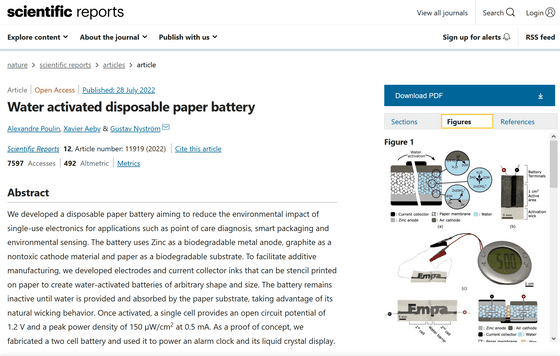'Paper Disposable Batteries' Activated When Sprinkled with Water

A new type of battery, the paper battery, was devised that was expected to minimize the impact on the environment. When the paper with salt kneaded in is moistened with water, the salt dissolves and works as an electrolyte.
Water activated disposable paper battery | Scientific Reports

A Water Activated Disposable Paper Battery | Advanced Batteries & Energy Storage Research
Scientists Invent a Paper Battery--Just Add Water - Scientific American
https://www.scientificamerican.com/article/scientists-invent-a-paper-battery-just-add-water/
The newly created paper battery is characterized by three types of ink printed on rectangular paper with a short side of about 1 cm. Salt is kneaded into the entire paper, and one short side is coated with wax. In addition, ink containing graphite flakes as a positive electrode is printed on one side of a flat paper, ink containing zinc powder as a negative electrode is printed on the other side of the paper, and another ink containing carbon black and graphite flakes is printed on both sides. It has been.
By adding a small amount of water to this, electrons are released, and an electric current is generated by an oxidation-reduction reaction. When the research team conducted an experiment to test the effect of paper batteries, when a few drops of water were added to one paper battery, the battery started working within 20 seconds, and the voltage of 1.2 V was stabilized until the paper dried. It seems that I was able to make it happen.

1.2V is equivalent to a nickel metal hydride battery, but since the paper battery was not connected to the device in this measurement, it is unknown if it will be the same voltage when connected to the device. However, it seems that it was possible to move the alarm clock with the liquid crystal display by connecting two paper batteries.
The performance of the paper battery decreased significantly in about 1 hour, but by adding more water, it was possible to generate a voltage of 0.5 V for more than 1 hour. Paper batteries are still a long way off from replacing existing dry cell batteries, but researchers envision a future where the batteries can be incorporated into sensors and other devices, providing a sustainable alternative to harmful batteries. It is said that there is.
Gustav Nystrom, who was involved in the research, said, 'I think the performance of this device is suitable for many applications. Going forward, the main challenge is to increase the scale of production and incorporate batteries into many systems.' said.
Related Posts:







